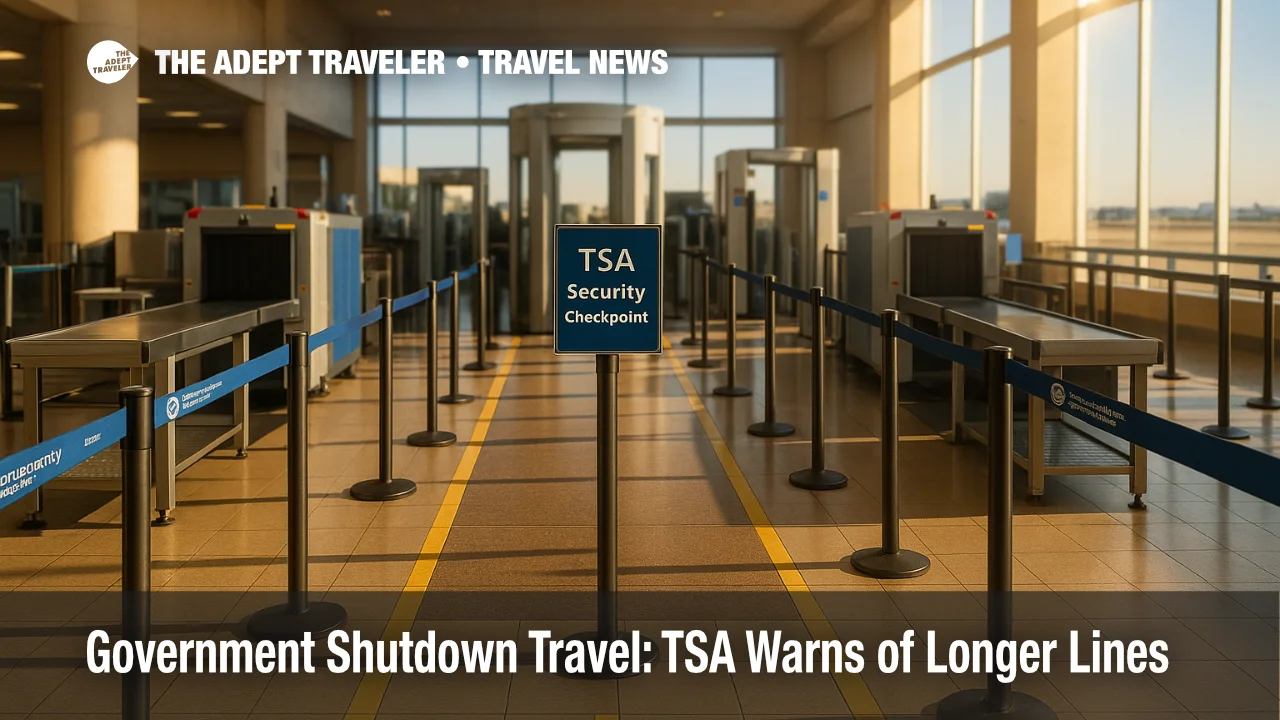Government shutdown travel: TSA warns of longer lines

As the federal government shutdown stretches beyond October 1, the Transportation Security Administration is urging patience at checkpoints while it keeps screening operations running. TSA says it can process about 2.5 million travelers per day, but warns that an extended funding lapse could translate into longer lines at major airports. The Federal Aviation Administration has kept roughly 13,000 air traffic controllers on the job without pay under Department of Transportation contingency plans, while thousands of other FAA staff are furloughed, increasing strain across the system. Travelers should expect uneven conditions if the impasse continues.
Key points
- Why it matters: TSA and FAA remain operational, but staffing stress can ripple into delays and cancellations.
- Travel impact: Expect longer TSA lines and occasional flow restrictions if controller staffing stays stretched.
- What's next: If the shutdown persists, more FAA support roles stay offline, slowing modernization and training.
- Most controllers and TSA officers must work without pay until appropriations return.
- 2018-2019 precedent shows rising sick calls and tactical checkpoint closures after missed paychecks.
Snapshot
Under DOT's shutdown plan, about 13,000-plus air traffic controllers remain "excepted" and continue working without pay, while more than 11,000 other FAA employees are furloughed. TSA says it is prepared to screen roughly 2.5 million passengers a day, but cautions that wait times may grow if the shutdown drags on. Industry advocates warn the longer the impasse lasts, the more likely travelers will encounter checkpoint bottlenecks, ground-delay programs, and slower service at federal touchpoints. Travelers should build extra time at departure airports, monitor airline apps for gate or schedule changes, and review carrier waiver policies. For broader context and day-by-day travel tips, see our earlier coverage: Government shutdown: What flyers should expect today, How a government shutdown could affect travel, and Government shutdown travel: What to expect if it drags on.
Background
During the 35-day lapse in 2018-2019, rising absenteeism among unpaid checkpoint officers produced hour-plus lines at peak hubs, and Miami International Airport (MIA) temporarily consolidated operations. FAA slowed traffic at times as controller staffing and equipment issues compounded. Today's environment is tighter: FAA's own workforce plan shows persistent controller shortages that predate the current shutdown, leaving little cushion for disruptions. NATCA, the controllers' union, says mandatory overtime is already common and that the prolonged absence of support staff, procedures updates, and training resources forces front-line teams to compensate. Meanwhile, DOT's consolidated lapse plan keeps core safety functions running but halts many non-critical activities, which can delay modernization projects and training pipelines if the funding gap continues.
Latest developments
How a prolonged government shutdown affects TSA screening and ATC staffing
TSA has reiterated that daily screening will continue nationwide, with approximately 2.5 million passengers expected each day; however, extended unpaid periods historically correlate with increased sick calls and tactical checkpoint consolidations. On the airspace side, DOT's September 30 contingency plan keeps more than 13,000 controllers in the tower and centers, but furloughs over 11,000 other FAA personnel whose work underpins procedures, briefings, and tech support. NATCA leadership warns the system is already at "critical staffing" and operating with unreliable equipment in some facilities, heightening brittleness as the shutdown lengthens. The U.S. Travel Association estimates industry losses could approach $1 billion per week if the lapse persists. Expect the FAA to meter departures or slow arrival rates during peak periods at complex hubs when demand eclipses safe staffing or equipment availability.
Analysis
The immediate takeaway for travelers is continuity with caveats: planes will fly, checkpoints will open, and towers will stay staffed. The risk comes from duration. After a missed paycheck, absenteeism typically rises among unpaid front-line workers, and agencies must make tactical choices-consolidating checkpoints, reducing lanes, or pacing traffic flow-to maintain safety and security. With an existing controller shortfall, any incremental stress lands on a thinner bench. Support specialists who manage procedures, tech updates, and training are exactly the roles furloughed first in a shutdown, constraining throughput even if core operations soldier on. That cascade shows up for travelers as longer queues, pop-up ground delays, and slower recovery from routine disruptions like weather. The 2018-2019 experience offers a template; the current baseline is tighter, so effects could materialize sooner if the funding lapse lingers. The prudent move is to add time at departure, fly earlier in the day when buffers are better, and keep airline apps on for real-time changes. If Congress resolves funding quickly, most impacts should unwind within days; if not, expect a stickier, system-wide drag.
Final thoughts
A short shutdown mainly tests patience at the checkpoint and resilience in busy airspace. A longer one amplifies risk as unpaid workers face mounting strain and critical support functions stay dark, constricting throughput. Travelers can blunt the pain by building extra time, carrying compliant liquids and electronics to speed screening, and booking earlier flights with more recovery options. Keep an eye on carrier alerts and FAA delay programs during peak periods. If the impasse persists, expect more frequent metering and checkpoint consolidations at major hubs as agencies prioritize safety. We will continue tracking policy moves, staffing signals, and operational metrics tied to government shutdown travel.
Sources
- DOT consolidated lapse plan, September 30, 2025, U.S. Department of Transportation (PDF)
- Controller Workforce Plan FY2025, Federal Aviation Administration (PDF)
- NATCA calls on Congress to end the government shutdown, National Air Traffic Controllers Association
- $1 billion lost every week: Impact of a government shutdown, U.S. Travel Association
- FAA would furlough 11,000 employees in U.S. government shutdown, Reuters
- Shutdown puts further strain on already understaffed air traffic control system, PBS NewsHour
- TSA warns travelers of possible delays during government shutdown, TravelPulse
